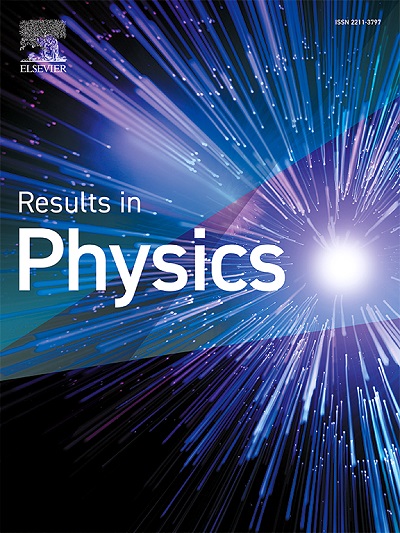Numerical investigation of thin film flow over a porous, non-flat moving sheet with nonlinear kinematics
IF 4.4
2区 物理与天体物理
Q2 MATERIALS SCIENCE, MULTIDISCIPLINARY
引用次数: 0
Abstract
Flow of viscous thin film has previously been studied over a flat, porous and moving plate, whereas, these investigations are carried out for particular cases of uniform and linearly variable injection, suction, stretching and shrinking velocities. Moreover, the mechanisms of injection/suction and stretching/shrining have been analyzed individually and jointly for such flows. The present simulation has generalized the steady flow models of viscous thin film over porous, stretching and shrinking sheet of nonuniform thickness. We explored new and multiple dimensions of classical problems of thin film flow and analyzed it. Here, we categorically emphasized on the steady nature and kinds of injection (suction) and moving velocities of the sheet, whereas, steady form and variable size of the sheet are also taken into account. We formed different variables and investigated nonlinear cases of steady nature and checked different options for the two components of velocity, defined at the surface of sheet, variable sizes of the thin film and that of sheet. By analyzing all possible cases, we identified exact similarities that allowed the system of partial differential equations and boundary conditions to be precisely converted into ordinary differential equations based on these new variables. The transformed equation of continuity has two dimensionless parameters, which show that mass can be added/removed to/from the flow regime through two sources i.e. mass can be added/removed to/from the system by (i) injection/suction through porous sheet (ii) condensation/evaporation into/from the free surface. The system of exact ordinary differential equations is solved by bvp4c technique. Whereas, exact solutions of the system are also found under some restrictions on the parameters value. Besides that the two solutions are exactly matched to each other. Moreover, the present simulations are completely matched with the previously published work of this type for appropriate choices of functions and parameters. Note that the strict behavioral changes in the velocity profiles and skin friction coefficient are observed by changing the sign of parameters.
具有非线性运动学的多孔非平面运动薄片上薄膜流动的数值研究
粘性薄膜的流动以前已经在一个平坦的、多孔的和移动的板上进行了研究,然而,这些研究是在均匀的和线性可变的注射、吸入、拉伸和收缩速度的特殊情况下进行的。此外,还分别分析了此类流动的注射/吸力和拉伸/收缩机理。本文的模拟推广了粘性薄膜在非均匀厚度多孔、拉伸和收缩薄片上的稳定流动模型。我们对经典的薄膜流动问题进行了新的多维度的探索和分析。在这里,我们明确地强调了稳定的性质和种类的注射(吸)和移动速度的板,而稳定的形式和可变尺寸的板也被考虑在内。我们形成了不同的变量,研究了稳定性质的非线性情况,并检查了在薄片表面定义的两个速度分量的不同选项,薄膜的可变尺寸和薄片的可变尺寸。通过分析所有可能的情况,我们确定了精确的相似性,使得偏微分方程和边界条件系统能够精确地转换为基于这些新变量的常微分方程。转换后的连续性方程具有两个无量程参数,表明质量可以通过两个来源向流动区添加/移除,即质量可以通过(i)通过多孔板的注入/吸入(ii)在自由表面的冷凝/蒸发(ii)向自由表面的冷凝/蒸发向系统添加/移除。用bvp4c技术求解了一类精确常微分方程组。同时,在一定的参数限制条件下,也得到了系统的精确解。除此之外,这两个解是完全匹配的。此外,在适当选择函数和参数方面,本文的模拟与先前发表的该类工作完全匹配。注意,速度曲线和表面摩擦系数的严格行为变化是通过改变参数的符号来观察的。
本文章由计算机程序翻译,如有差异,请以英文原文为准。
求助全文
约1分钟内获得全文
求助全文
来源期刊

Results in Physics
MATERIALS SCIENCE, MULTIDISCIPLINARYPHYSIC-PHYSICS, MULTIDISCIPLINARY
CiteScore
8.70
自引率
9.40%
发文量
754
审稿时长
50 days
期刊介绍:
Results in Physics is an open access journal offering authors the opportunity to publish in all fundamental and interdisciplinary areas of physics, materials science, and applied physics. Papers of a theoretical, computational, and experimental nature are all welcome. Results in Physics accepts papers that are scientifically sound, technically correct and provide valuable new knowledge to the physics community. Topics such as three-dimensional flow and magnetohydrodynamics are not within the scope of Results in Physics.
Results in Physics welcomes three types of papers:
1. Full research papers
2. Microarticles: very short papers, no longer than two pages. They may consist of a single, but well-described piece of information, such as:
- Data and/or a plot plus a description
- Description of a new method or instrumentation
- Negative results
- Concept or design study
3. Letters to the Editor: Letters discussing a recent article published in Results in Physics are welcome. These are objective, constructive, or educational critiques of papers published in Results in Physics. Accepted letters will be sent to the author of the original paper for a response. Each letter and response is published together. Letters should be received within 8 weeks of the article''s publication. They should not exceed 750 words of text and 10 references.
 求助内容:
求助内容: 应助结果提醒方式:
应助结果提醒方式:


